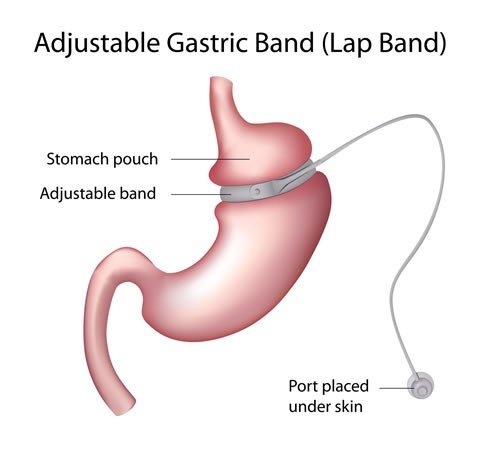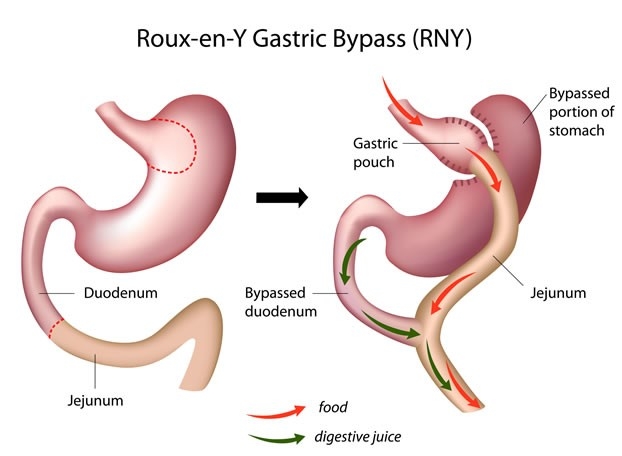There are several types of weight loss surgery performed in Australia, and they fall into two different categories. Restrictive, which means the surgery restricts amount of food the stomach can hold, and Malabsorptive, which means the stomach finds it harder to absorb calories, fat and nutrients. The most common type is the restrictive surgery, in particular the gastric banding surgery.
Adjustable Gastric Banding Surgery – restrictive surgery

This bariatric surgery involves the placement of a silicone band around the upper part of the stomach which assists in weight loss by limiting food intake, reducing appetite and slowing digestion.
As the patient loses weight the band can be adjusted to ensure its effectiveness.
This procedure is a weight loss solution that is scientifically proven, safe, reversible and effective in getting the weight off and keeping it that way.
This surgery is also known as Lap band, gastric band and LAGB.
What Can Be Expected From The Procedure
The gastric banding procedure itself takes 30 – 45 minutes.
The surgeon will make a small incision in the stomach and carbon dioxide is used to inflate the abdomen to give the surgeon room to work. Then a tiny camera is inserted through the incision into the abdomen and the surgeon uses this to complete the surgery. More incisions are made into the abdomen to assist in creating a tunnel behind the patient\’s stomach.
The gastric band is inserted through this tunnel and put into place around the stomach. An access port is also created from the band into the abdomen wall.
This is usually a hospital stay of 1-2 nights, but 1-2 weeks recovery off work may be required.
How Does It Work
The gastric band has created a small pouch that holds approximately ½ cup of food. An average stomach holds about 6 cups.
The gastric band slows down the passage of food into your main stomach from the small pouch above the band. The slight stretching of the small pouch registers to the brain that the whole stomach is full and that you are satisfied. This means you feel full on less food and for a longer period of time.
As patients lose weight the lap band will need adjustments. This involves introducing a saline solution through the access port which inflates the band and makes it tighter, decreasing the passage between the pouch and the stomach.
Everyone is different when it comes to the number of adjustments and tightness. Often you will have 2-3 adjustments before you experience the true effect of appetite control with the gastric band.
Sleeve Gastrectomy Surgery – restrictive surgery

Also known as laparoscopic sleeve gastrectomy or LSG. This weight loss surgery involves the removal of the lateral 2/3rds of the stomach (70-80%) using a staple like device. This can be done by keyhole surgery.
The stomach is still able to function normally but the area that produces the hunger stimulating hormone (Ghrelin) has been removed and the reduced stomach volume helps you to feel full on smaller amounts of food.
What Can Be Expected From The Procedure
The Sleeve Gastrectomy is usually done laparoscopically (via keyhole). Small incisions are made in the stomach area and the surgical instruments used are inserted through these incisions to remove up to 85% of the stomach.
The sides are then stapled together, leaving the stomach smaller and tubular in shape. The sphincter muscles at the top and bottom of the stomach have been retained to ensure the stomach still functions as normal.
The surgeon then checks the stomach to make sure it is joined correctly and there is no chance of leakage and finally the incisions are closed.
This surgery usually requires a hospital stay of between 1-3 days and the average recovery time is between 1-2 weeks.
How Does It Work
The sleeve gastrectomy procedure limits the amount of food you are able to eat and helps you feel full quicker.
This is due to the stomach being smaller as well as the absence of the hunger-stimulating hormone.
Food consumed passes through the digestive tract in the usual order, allowing it to be fully absorbed in the body through normal digestion.
Gastric Balloon (OrberaTM) – restrictive surgery
The gastric balloon is technically a non-surgical procedure which involves placing a balloon within the stomach which is filled with saline solution to create the feeling of fullness.
What Can Be Expected From The Procedure
This procedure is not classed as surgical, as it is minimally invasive.
The soft, silicone balloon is inserted into the stomach through the mouth via a tiny camera. Once the empty balloon is in place, it is filled with a sterile, saline solution. The filled balloon then occupies a large area of the stomach.
The procedure only takes 20 minutes to complete and usually doesn\’t require an overnight hospital stay. The balloon remains in place for 6 months and is then removed the same way it was inserted. During the 6 months, the patient must follow a suitable plan to prevent the weight from creeping back on.
Having a gastric balloon inserted assists the patient to change lifestyle and dietary patterns prior to the removal of the gastric balloon.
How Does It Work
The saline filled balloon occupies a significant portion of the stomach and as a result creates a feeling of fullness.
It temporarily reduces hunger and food intake, which helps patients to generate new behaviours and eating patterns to help them manage their weight long term.
It is essential that after the balloon is removed, the patient follow a suitable, supervised program to enable continued success.
Gastric Bypass – malabsorptive surgery

This type of surgery is also known as Roux-n-Y gastric bypass or bypass surgery. It is used to treat obesity by making the stomach smaller and allowing food to bypass a part of the small intestine.
Because of these changes, you will feel fuller more quickly, consume less and absorb fewer calories.
What Can Be Expected From The Procedure
Small incisions are made to the abdominal area and the stomach is inflated with carbon dioxide to make the area easier for your surgeon to work.
The surgery is done via a video feed from a tiny camera inserted through one of the incisions.
The surgeon then creates a small pouch at the top of the stomach, using surgical staples or sutures. The smaller stomach is then connected directly to the middle part of the small intestine and bypasses the rest of the stomach and the upper part of the small intestine. The larger section of the stomach remains intact and functional, its purpose is to secrete the necessary enzymes for digestion into the small intestine.
How Does It Work
The gastric bypass reduces your portion sizes as the size of the stomach has been reduced.
You will also feel satisfied and full after only small portions and due to the intestinal bypass, less calories are absorbed.
This procedure is very successful in achieving weight loss, but changes within your lifestyle and appropriate food choices are vital for optimal results.
It is also important when considering the bariatric surgery type that best suits you and your health care needs that you discuss your options with your doctor and surgeon.
It is important that you find a surgeon that you are comfortable with.

If you have any further questions about dietary changes associated with any of the weight loss surgery options or would like to discuss which one would be best suited to you, please feel free to contact us and book a time to speak with the EvolvME dietitians.
